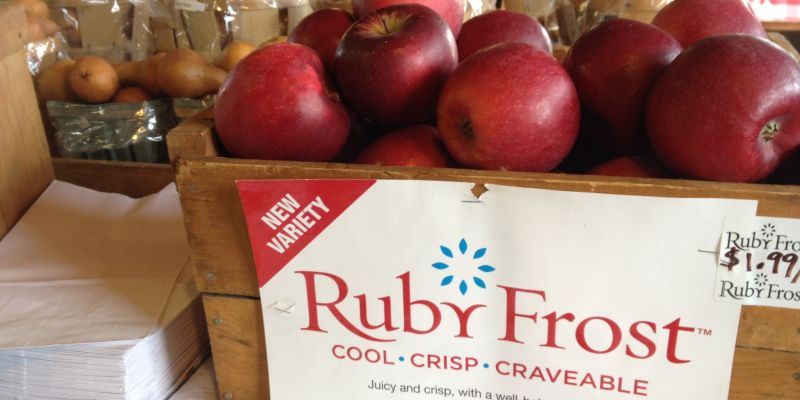
Great wines take years to develop and, if more than one grape is used, care in achieving the proper blend. The same is true of great apple varieties.
Two new apples now in limited release, SnapDragons™ and RubyFrosts™, have recently been available nearby at Dressel Farms, New Paltz and Hurd’s Family Farm, Modena. How’d that happen?
Since 1890, Cornell University has released sixty-six new varieties, including standbys like Cortland, Macoun, Empire and Jonagold. To become successful, a new variety has to have more than just great taste. It also has to be producer/seller friendly, resistant to such things as powdery mildew, scab, fireblight, soft scald and bitter pit. It has to resist pre-harvest drop, store well and have good shelf life.
Dr. Susan K. Brown, Associate Director of Cornell’s New York State Agricultural Experiment Station (NYSAES) and Herman M. Cohn Professor of Horticulture, heads the apple breeding program at Geneva, NY. With 57,000 genes in the apple’s genome, it’s not surprising that Cornell plants 10,000 seeds a year or that it took Dr. Brown twelve years to develop the SnapDragon™, whose parents were Honeycrisp and another apple in her breeding program similar to Jonagold. RubyFrost™’s parents were Braeburn and Autumn Crisp, and that variety took seventeen years to perfect.
Dr. Brown explained a new approach, “Cornell developed well known apples like the Cortland, Macoun, Empire and Jonagold. But those varieties took thirty, forty or more years to really catch on. With SnapDragon™ and RubyFrost™, we tried a new approach.
“In our apple breeding program these two varieties, originally NY1 and NY2, showed such promise that when we showed them to New York growers, they were sufficiently enthusiastic that the roll out became a joint venture.”
Rod Dressel, Jr., of Dressel Farms, New Paltz picked up the story. “In 2010, New York Apple Growers, LLC (NYAG) was formed specifically to market these two new varieties and to share the commercial benefits with Cornell. All 700 commercial apple growers in New York State were offered a chance to participate. But it was like buying a pig in a poke. These two varieties showed great promise but had no track record or knowledge by consumers.” Ultimately, only 145 New York State apple growers, representing about 60% of the state’s production, became members of NYAG.
Cornell granted NYAG an exclusive North America license for SnapDragon™s and RubyFrost™s, for which NYAG members pay royalties on trees purchased, acreage planted and fruit produced. Half the royalties go to support NYAG and their marketing efforts—with their share NYAG was able to hire Full Tilt Marketing to design the logos for the two new apples and get the message out—and the other half is retained by Cornell. A portion of Cornell’s share goes directly to the apple breeding program to further that work.
In addition to the commercial risk, growers in the “club” had the upfront capital costs of fencing acreage for the two new varieties, providing support systems, particularly for the weaker SnapDragon™ trees (actually, buds grafted to root stock), and laying water lines. And then there’s the lag from first planting to commercially viable harvest.
Because initially there would be a small number of trees available, preference was given to NYAG members who had roadside stands so as to get the word out and maximize the distribution of the limited availability. Dressel Farms applied for three acres of SnapDragon™s and two of RubyFrost™s. In 2011, they received only enough trees to plant a half acre—and Rod’s customers got to sample the limited but delicious results of that harvest this past fall. In 2012, they got a few more and in 2013, enough for the full three acres of SnapDragon™s and two acres of RubyFrost™s. Within seven years, Rod Dressel expects to get about 2,000 bushels of apples per acre.
In an interview on National Public Radio (NPR), Dr. Brown summed up the qualities of these two apples. “If you’re a fan of Honeycrisp apples, SnapDragon™ is similar. It has a crisp texture. The cells rupture rather than separate, which gives it a real crunchiness. RubyFrost™ is very crisp, juicy and grower friendly. It doesn’t fall off the tree when it ripens and it has good resistance to flesh browning when the apples are cut. Plus, it has a nice sugar-acid ratio.”
SnapDragon™ can be harvested early, in late September, but its long storage and shelf life mean retailers can offer it with consistent quality for longer than Honeycrisp. According to Dr. Brown, only about 40% of Honeycrisps produced are saleable. RubyFrost™ ripens later, stores well and so can be available well into winter.
To sense the broader market, NYAG began test marketing SnapDragon™s and RubyFrost™s in several chain grocery stores in New York in January. As far as whether these apples will be grown more widely, Rod Dressell says, “When and if these two new varieties are grown outside New York State will ultimately be up to NYAG.”
